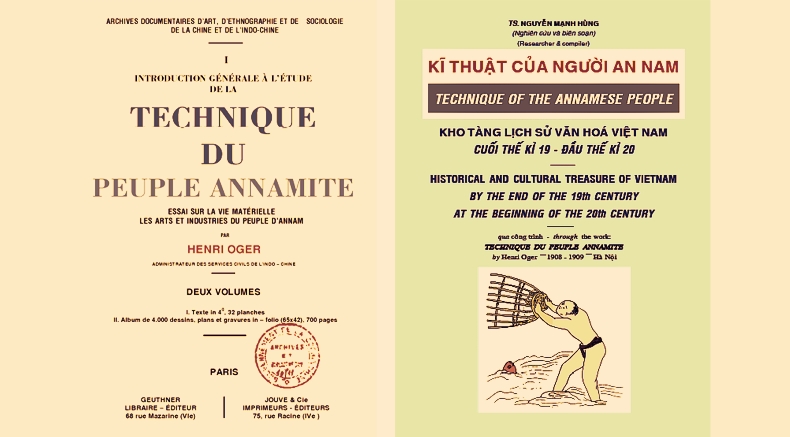How was this SET of DOCUMENTS “Technique of the Annamese People” DISCOVERED and NAMED?
Hits: 423
Asso. Prof. HUNG, NGUYEN MANH, PhD.
1. In the capital city of Hanoi, since the 50’s and 60’s, a number of well-known veteran painters such as Nguyen Do Cung, Tran Van Can, etc. and certain young researchers have begun to pay attention to a large number of
woodcuts, achieved towards the beginning of the twentieth century, that belong in a set of documents which the aforesaid people had started to carry out fact-finding investigations and to study. Later on, various research
Institutes such as: the Institute of History, the Art Institute, the Institute for the Compilation of Encyclopaedias, the South-East-Asia Institute, the Chinese and Chinese transcribed Vietnamese Institute, the Language Institute, etc. have also come into contact with the above-mentioned set of documents.
In the former city of Saigon, maybe towards the 60’s, the Archaeological Institute and several researchers had known about and had tried to learn about that original set of books, especially in the 70’s, when people saw the appearance of a number of the aforesaid woodcuts under the title of “Vietnamese Woodcuts, at the Beginning of the Twentieth Century.” (1)
2. In Paris, in April 1978, the Social Sciences Review (Paris) had published an article entitled “Folk Art through 650 Newly Recovered Woodcuts” (2).
Two months later, an Exposition had been organized at the Cultural House of the Town of Bourges (France) bearing in large capital letters the title: “Peasant artists of Vietnam” (3).
3. Following this article and this Exposition a number of Vietnamese magazines abroad continued to introduce those woodcuts, and the Art Studies magazine in Hanoi had also republished the aforesaid article (issue No. 4/78).
In 1985, the Vietnamese Social Sciences Committee’s magazine “Encyclopaedic Knowledge” had introduced 351 sketches with the big title: “Encyclopaedia in Images” – extracted from the “Vietnamese Cultural and Material Encyclopaedia” – Woodcuts realized by Anonymous Artists at the beginning of the 20th century. (4)
Recently, on its Springtime Issue in the year “Mau Thin” (Year of the Dragon), the “Dat Viet” (Vietnamese Land magazine of the Association of Vietnamese) living in Canada had used 8 of those woodcuts to illustrate its articles on Tet with the annotation: “Newly collected woodcuts of the 20th century”, and right now, another number of magazines also pay attention to those woodcuts and try to exploit them.
Besides, we’ve seen two woodcuts showing a buffalo in each one of them, that were selected from that set of documents and published in a magazine to serve as illustrations for an article entitled: “The artless buffalo in paintings and sculptures”(5).
Worthy of attention is a set of books introducing our national culture (6) in which 26 out of the 30 illustrations are drawn after the ones in this set of documents.
4. Preliminary, we notice that, though this set of documents has been introduced at various moments and under different forms, it has never been introduced as a whole and uniformly. Therefore, this fact now raises many questions that require other answers:
a. Is it true that after falling into oblivion for a lapse of time of more than a half-century, the fate of a great national cultural treasure of the Vietnamese People “has begun to drift- alternatively disappearing and reappearing – along the flow of events” from Hanoi (in the 50’s) to Saigon (after 1954) and then “has again disappeared into some unknown far off horizon” (Paris-after 1975)?
b. Is it correct that the woodcuts in this set of documents belong to a new line of folk paintings – different from the familiar ones of Dong Ho village or Hang Trong street – or are these woodcuts. “a type of art” or “a different type of scientific research” still unrecognized? Perhaps, in the scope of this small introductory booklet, we oughtn’t go thoroughly into all the facets of these woodcuts and should only “describe them exactly as they are”, so as to avoid bestowing upon them “strange values” and thus unintentionally “hurting their intrinsic scientific values”.
NOTES:
(1) NGUYEN KHAC NGO – “Vietnamese Woodcuts towards the beginning of the 20th century” – Expounder Magazine – from issue No.1 to 10 in 1970.
(2) PHAM NGOC TUAN – Folk Art through 650 Woodcuts newly recovered – Social Sciences Review, Paris, issue No. 4/78.
(3) PHAM NGOC TUAN – The Peasant Painters of Vietnam – Exposition at the Cultural House of the town of Bourges (France) from June 10, 1978 to July 30, 1978, organized by the Association of Vietnamese living in France, working in coordination with the Museum of Man.
(4) In issues Nos. 3, 4, and 5, 1985 and issue No.1, October 1985 (separate reprint). (5) NGUYEÃN QUAÂN – The artless buffalo in paintings and sculptures – Vietnamese Literature Magazine – issue of Tet At Suu (Year of the Buffalo) (1985), p.12.
(6) NGUYEN THU – Illustrations for the set of books on Folk Songs and Poems of the Vietnamese People – A National Culture Palace (vol. 4) compiled by NGUYEN TAN LONG and PHAN CANH, Published by Song Moi publishing house in 1971 in Saigon.
NOTE:
◊ Source: Technique of the Annamese People by Henri Oger, 1908-1909. Dr. Nguyen Manh Hung, Researcher & Compiler.
◊ Featured image is sepiaised by Ban Tu Thu – thanhdiavietnamhoc.com
